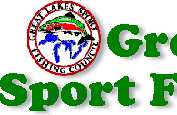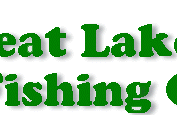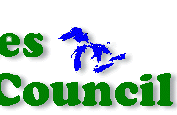





The equally, if not more important, afternoon was spent discussing issues and the four options offered to conference participants. The LMMA asked that only these four options be considered during the breakout sessions.
Options considered
In preliminary documents and a white paper mailed to potential conferees, comparison levels between 1998 and 1986 were offered by LMMA through their computer modeling, which predicted that the present lakewide stock of salmonids now equals or exceeds peak levels. Reference was also made to the SIMPLE model developed by the Great Lakes Fishery Commission in the mid-1980’s.
Highly touted at the time, SIMPLE (Sustainability of Intensively Managed Fish Populations in Lake Ecosystems) has proven to have an accuracy rate of about 15-20%. Bill Horns (WI DNR) acknowledged LMMA recognizes models and assumptions can be wrong, and that some parameters are difficult to estimate, but he added “we may be on the verge of another lakewide breakdown.”
Parking Lot Options
While
only four options were offered for consideration, the six breakout groups
generated options and variations of their own to achieve reduced salmon
stocks. Facilitators placed them in a “parking lot” for further consideration
by the LMMA. Over 60 variations were offered and facilitator John McKinney
highlighted those below in his wrap-up:
There was a marked difference between the two previous lakewide conferences - on coho and perch, held on April 9 and December 10, 1994 - and the rationale for holding the stocking conference.
The proposal to reduce stocking in Lake Michigan is really a success story in disguise. Cleaner water, improved stream conditions, enhanced habitat and dam removals all have played a roll in increased natural recruitment of Chinook (25-45%), steelhead (15-20%), and coho at 5%. LMMA advises upwards of 3 million Chinook salmon annually are added to the Lake Michigan biomass through natural means in addition to the approximately 13.8 million fish planted annually by the departments of natural resources of Illinois, Indiana, Michigan and Wisconsin (LMMA). Annual planting numbers have been fairly consistent for over 20 years.
BKD was another factor of consideration for the conference, as were other symptoms of ecosystem stress including poor recruitment of perch and chubs, and declines in growth rates of some salmonids. LMMA warns these stress indicators may be warning signals that stocking levels are exceeding the lake’s carrying capacity. Recent sampling also indicated BKD may again be on the rise.
In 1994 EMS (early mortality syndrome) in the four states’ hatcheries and a court order restricting coho egg collections severely reduced coho stocking opportunities. Simultaneously, the dramatic collapse of yellow perch and perch recruitment capabilities created another management emergency in the lake. Both issues forced reduced creel limits on the angling community and the elimination of commercial harvesting of yellow perch for the foreseeable future.
While consensus building was not a goal at any of the conferences, there was a sense of direction achieved at the first two. Not so with the stocking conference. There was no sense of direction offered the LMMAs, with a multitude of comments, questions and concerns traversing the spectrum of every option and opinion imaginable. If anything, a feeling of disco-fort over any stocking cuts and the continued emphasis on lake trout permeated the workshop. One conferee (Kowieski) alluded to verbal comments of the presenters expressing a desire for a salmon fishery, but their writings alluding to self sustaining populations of lake trout.
Rob Elliott (USFWS) put much of the proceedings in perspective with his question “What will be the balance of the future? Too many alewives? Too much mortality of Chinook?” There were no ready answers.
Another participant (Appleby) expressed concern the LMMA was not promoting Great Lakes fishing, with murmurs of agreement coming from the audience. Michigan DNR reps took exception to the comment, although some charter captains present even challenged Michigan. The other three state representatives were embarrassingly silent on the issue.
Another interesting angler observation was that gobies have been found in 140 ft. of water and lake trout are feeding on them.
Breakout Sessions
To obtain additional input on the pros & cons of each option, the conference was divided into six afternoon breakout sessions, established by pre-registration to reflect a good mix of all groups and states present in each session. They were facilitated by Sea Grant personnel. One facilitator claimed he had to scramble for input because he only had 4 anglers and 5 government types in his session. Some comments were:
Session
#1
The Pros & Cons were:
Pro:
Credits:
Thanks to the LMMA, specifically the four fish chiefs of Illinois, Indiana, Michigan and Wisconsin for sponsoring the conference and again recognizing the importance of dialog and information exchange between management and constituencies. While the process was not meant to be a consensus builder, it did accomplish the goal of generating information to constituencies — and in turn getting input back from those present. The process was a proven communication tool twice before, and to that extent it was successful again this time.
The LMMA is to be commended for its willingness and desire to get input from constituency groups on such an important and controversial matter.
The meeting was again moderated and facilitated by IL-IN and MI Sea Grant personnel. Our thanks to agents Pat Charlebois, Ron Kinnunen, Mike Klepinger, John McKinney, Brian Miller and Chuck Pistis who moderated the day’s proceedings.
As late as Friday evening September 11, there was an LMMA desire to change the moderator from a Sea Grant member to an angler — the chairman of the U.S. Advisors committee to the Great Lakes Fishery Commission. It was opposed by the GLSFC on the basis of perceived compromise to neutrality, impartiality, credibility and professionalism by everyone attending the conference, and that Sea Grant would more comfortably fill that role.
The Great Lakes Sport Fishing Council hosted the meeting.
Video Taping:
The information dissemination portion of the meeting (plenary) was audio/video-taped by Wisconsin DNR. This will be a valuable management tool. The tape may be made available at cost plus shipping charges, if enough interest is generated. Our thanks to Bill Horns for a copy of this tape.
Meeting Date
In response to questions raised by more than one conferee on the date selected for the meeting, Indiana Fish Chief Bill James stated “There is no good time for such a conference.” This is especially true considering management’s position. If the decision is made to cut stocks it must be before eggs are collected at weirs. If a decision to cut stocks were made after eggs were collected and surplus eggs had to be trashed, it could be a politically fatal decision for some personnel and was widely perceived as unsound, with probable bureaucratic repercussions.
However, in consideration of those targeted for attendance — the angling community — the date selected was one of the worst (attendance reflected that), and everyone involved in the recreational fishing industry knows it. In April 1994 there were 93 angler reps/leaders present at the Coho conference, and in December 1994, there were 119 anglers and 27 commercials present at the Perch conference. For this workshop there were 40 anglers, 6 charter captains, 10 observers, 6 Sea Grant facilitators and 31 government types present. If anglers are to be better represented at such meetings, more consideration must be given to date selection.
Lake Trout program
Management expressed surprise over vocal opposition to the emphasis placed on the lake trout program by LMMA. The sport fishing community enjoys the five species mix being planted in the lake and desires it to be continued in proportionate measures. It is strongly opposed to the disproportionate emphasis placed on this species, the federal emphasis on only lake trout and the hundreds of millions of tax dollars being spent on this philosophically and biologically flawed and, to date, woefully unsuccessful program.
Breakout Sessions
Although DNR personnel attended the breakout sessions, their input was to be limited to observers and to clarify a question if called on. However, in four of the sessions their input consisted of dialog and debate on various comments offered by anglers — possibly intimidating others from speaking openly and without reservation. One facilitator had to repeatedly ask one DNR member to refrain.
Fish Community Objectives (FCO)
The Lake Michigan Fish Community Objectives were often referred to in the papers issued by the LMMA in preparation for the Stocking Conference. These same FCOs were soundly rejected in their original form by the sport fishing community, when circulated for public comment. Yet they were distributed in 1995 without change, and are as contentious today as they were four years ago. LMMA’s white paper is laced with references to their FCO and the “Preservation and enhancement of natural reproduction of native fish,” with reference to salmonids almost as an afterthought or appeasement process. There continues to be a perception permeating throughout the sport fishing community that lake trout are perceived by LMMA and the feds to be the salvation of the Great Lakes. This view is rejected by the sport fishing community.
If and when these Lake Michigan Fish Community Objectives are revised to better conform to contemporary concerns and needs, the angling community must be invited to participate in the revision process — not after the fact when the document is circulated for comments. Only then will a true partnership spirit be achieved and a document generated that expresses a consensus approach to ecosystem management to Lake Michigan’s resources. ----------------- If, as one speaker said, “Chinooks are the ecosystem managers of Lake Michigan,” they are also Mother Nature’s machine that drives both this recreational fishery and the economic dynamics. ----------------
Stocking
Conference Statistics
| Registration: |
| 95 Registered |
| 79 Paid |
| 93 Present |
| Individuals by Affiliation: |
| 4 Fish Chiefs |
| 1 COTFMA |
| 5 IL DNR |
| 4 IN DNR |
| 11 MI DNR |
| 6 WI DNR |
| 2 IL- IN Sea Grant |
| 4 MI Sea Grant |
| 46 Sportfishing Reps/leaders |
| 10 Observers |
| 93 Total Present |
| Sportfishing Reps/Leaders by State: |
| 11 Illinois |
| 7 Indiana |
| 22 Michigan |
| 6 Wisconsin |
| 46 Total Present |
| Sportfishing Organizations by State: |
| 6 Illinois |
| 3 Indiana |
| 7 Michigan |
| 3 Wisconsin |
| 19 Total Organizations |
| Represented Sportfishing Organizations: |
| 1. Chicago Sportfishing Association |
| 2. Green Bay Area GLSF WI |
| 3. Holland Area Steelheaders MI |
| 4. Illinois Council – Trout Unlimited IL |
| 5 Illinois Steelheaders IL |
| 6. Lake County Fish & Game IN |
| 7. Ludington Area Charter Association |
| 8. Michianna Steelheaders IN |
| 9. Michigan Anglers Association MI |
| 10. Michigan Charter Boat Association MI |
| 11. Michigan Council – Trout Unlimited MI |
| 12. Michigan Steelheaders MI |
| 13. Michigan United Conservation Clubs MI |
| 14. Milwaukee – GLSF WI |
| 15. Perch America IL |
| 16. Salmon Sport Fishing Club IL |
| 17. Salmon Unlimited – IL IL |
| 18. Sheboygan Charter Captains Association WI |
| 19. Steelheaders of NW Indiana IN |
| 20. SW Michigan Steelheaders MI |
| 21. Trout Unlimited – Donnelley Chapter IL |
| 3 Commercials |
| 2 Media |
| 1 NYSDEC |
| 1 USFWS |
| 1 GLFC |
| 1 USGS-BRD |
| 1 Environmentalist |
| 10 Total |
Comparison of Conferences:
| . | Coho | Perch | Stocking |
| #Sportfishing Reps/leaders | 93 | 120 | 46 |
| Sportfishing Organizations | 46 | 47 | 19 |
| Government (all agencies) | 32 | 39 | 35 |
| Sea Grant | 4 | 6 | 6 |
| Total present | 129 | 193 | 93 |
COUNCIL HOME
| GREAT LAKES
STATES'
| GLSFC
MEMBERSHIP
EXOTICS UPDATE
| BASIN REPORT
|
PENDING ISSUES
| REGIONAL REPORTS
|
GREAT LINKS
| HOT NEWS
|

YOUR COMMENTS
AND
SUGGESTIONS WELCOMED!
You may e-mail Dan Thomas at [email protected]